HRM Assignment: Human Resource Management Practices
VerifiedAdded on 2020/11/12
|16
|5568
|293
AI Summary
This assignment delves into the world of Human Resource Management (HRM), analyzing the effects of HRM practices on employee performance. It draws from a range of research studies and academic papers, including articles from esteemed journals such as the Journal of Business Ethics, International Journal of Human Resource Management, and Review of Public Personnel Administration. The assignment examines how HRM practices influence job satisfaction, organizational performance, and leadership style, providing valuable insights for HR professionals and students alike.
Contribute Materials
Your contribution can guide someone’s learning journey. Share your
documents today.
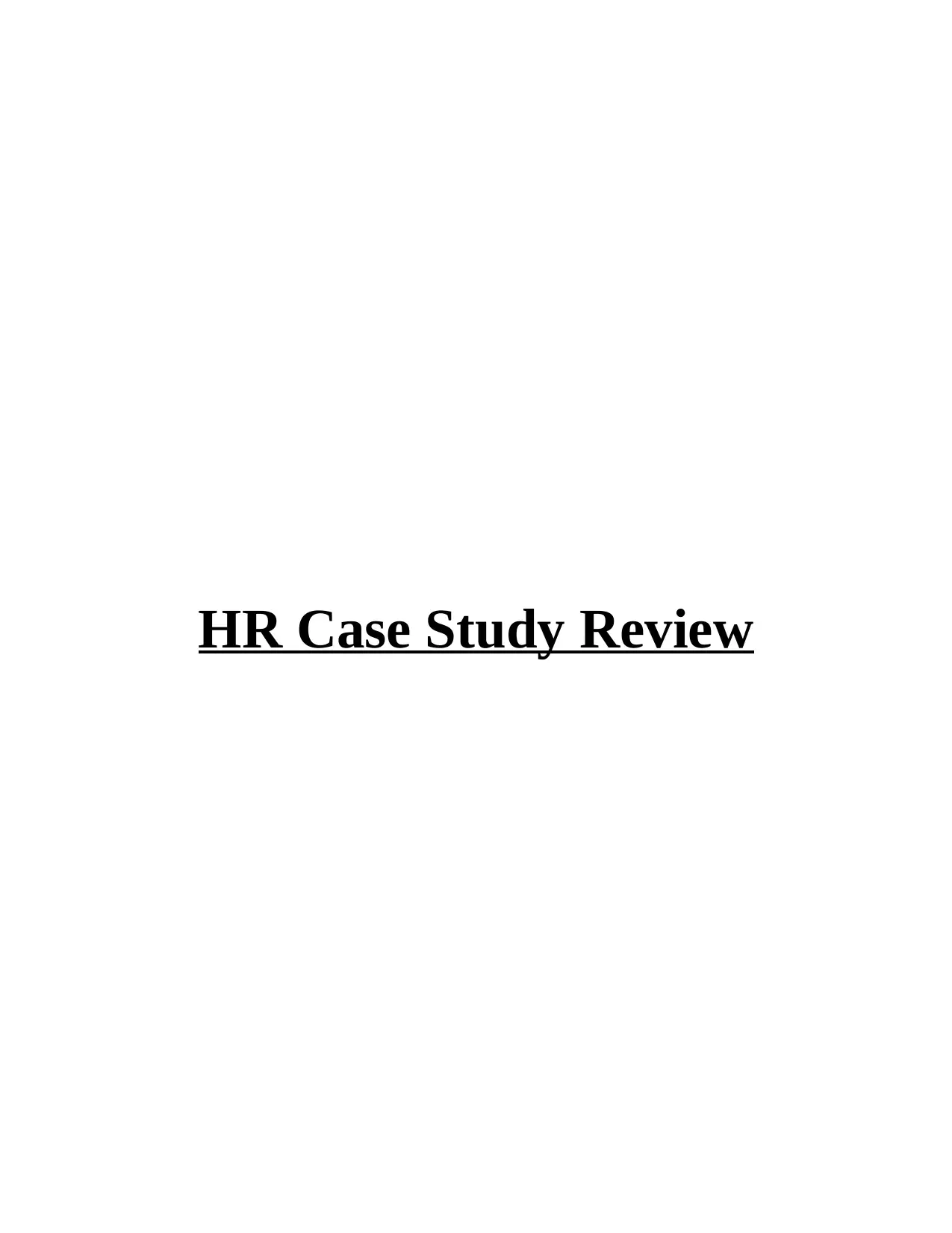
HR Case Study Review
Secure Best Marks with AI Grader
Need help grading? Try our AI Grader for instant feedback on your assignments.
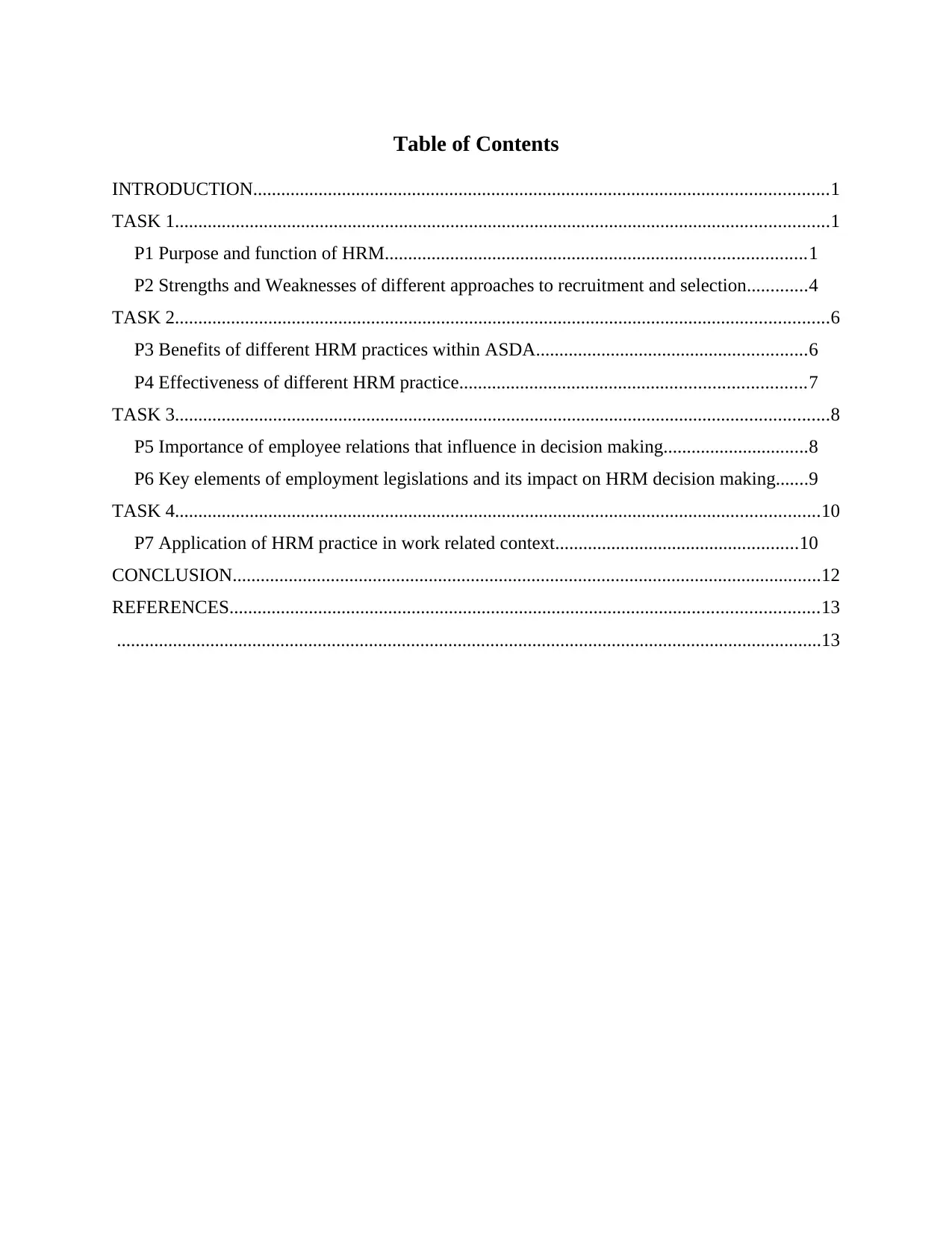
Table of Contents
INTRODUCTION...........................................................................................................................1
TASK 1............................................................................................................................................1
P1 Purpose and function of HRM..........................................................................................1
P2 Strengths and Weaknesses of different approaches to recruitment and selection.............4
TASK 2............................................................................................................................................6
P3 Benefits of different HRM practices within ASDA..........................................................6
P4 Effectiveness of different HRM practice..........................................................................7
TASK 3............................................................................................................................................8
P5 Importance of employee relations that influence in decision making...............................8
P6 Key elements of employment legislations and its impact on HRM decision making.......9
TASK 4..........................................................................................................................................10
P7 Application of HRM practice in work related context....................................................10
CONCLUSION..............................................................................................................................12
REFERENCES..............................................................................................................................13
.......................................................................................................................................................13
INTRODUCTION...........................................................................................................................1
TASK 1............................................................................................................................................1
P1 Purpose and function of HRM..........................................................................................1
P2 Strengths and Weaknesses of different approaches to recruitment and selection.............4
TASK 2............................................................................................................................................6
P3 Benefits of different HRM practices within ASDA..........................................................6
P4 Effectiveness of different HRM practice..........................................................................7
TASK 3............................................................................................................................................8
P5 Importance of employee relations that influence in decision making...............................8
P6 Key elements of employment legislations and its impact on HRM decision making.......9
TASK 4..........................................................................................................................................10
P7 Application of HRM practice in work related context....................................................10
CONCLUSION..............................................................................................................................12
REFERENCES..............................................................................................................................13
.......................................................................................................................................................13
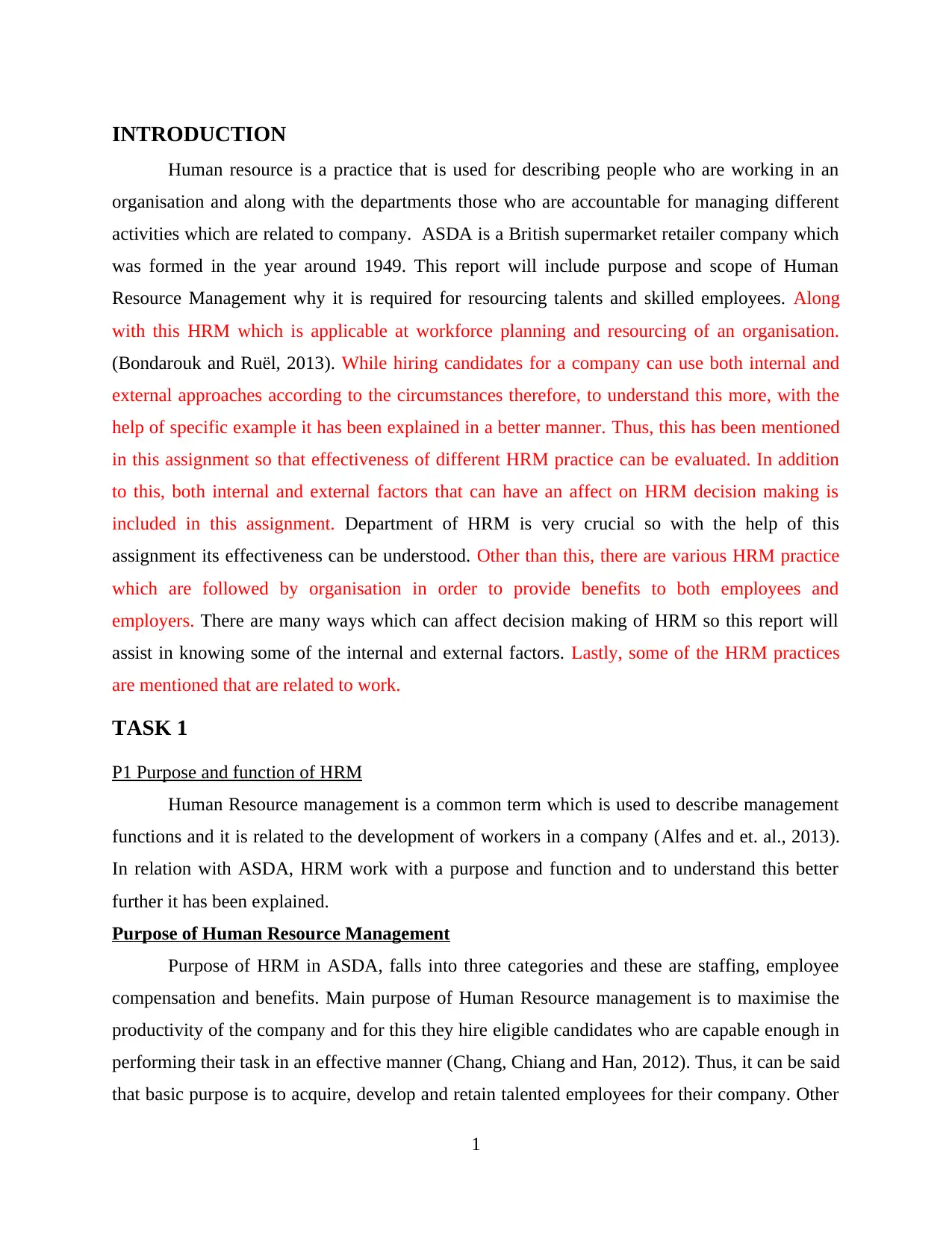
INTRODUCTION
Human resource is a practice that is used for describing people who are working in an
organisation and along with the departments those who are accountable for managing different
activities which are related to company. ASDA is a British supermarket retailer company which
was formed in the year around 1949. This report will include purpose and scope of Human
Resource Management why it is required for resourcing talents and skilled employees. Along
with this HRM which is applicable at workforce planning and resourcing of an organisation.
(Bondarouk and Ruël, 2013). While hiring candidates for a company can use both internal and
external approaches according to the circumstances therefore, to understand this more, with the
help of specific example it has been explained in a better manner. Thus, this has been mentioned
in this assignment so that effectiveness of different HRM practice can be evaluated. In addition
to this, both internal and external factors that can have an affect on HRM decision making is
included in this assignment. Department of HRM is very crucial so with the help of this
assignment its effectiveness can be understood. Other than this, there are various HRM practice
which are followed by organisation in order to provide benefits to both employees and
employers. There are many ways which can affect decision making of HRM so this report will
assist in knowing some of the internal and external factors. Lastly, some of the HRM practices
are mentioned that are related to work.
TASK 1
P1 Purpose and function of HRM
Human Resource management is a common term which is used to describe management
functions and it is related to the development of workers in a company (Alfes and et. al., 2013).
In relation with ASDA, HRM work with a purpose and function and to understand this better
further it has been explained.
Purpose of Human Resource Management
Purpose of HRM in ASDA, falls into three categories and these are staffing, employee
compensation and benefits. Main purpose of Human Resource management is to maximise the
productivity of the company and for this they hire eligible candidates who are capable enough in
performing their task in an effective manner (Chang, Chiang and Han, 2012). Thus, it can be said
that basic purpose is to acquire, develop and retain talented employees for their company. Other
1
Human resource is a practice that is used for describing people who are working in an
organisation and along with the departments those who are accountable for managing different
activities which are related to company. ASDA is a British supermarket retailer company which
was formed in the year around 1949. This report will include purpose and scope of Human
Resource Management why it is required for resourcing talents and skilled employees. Along
with this HRM which is applicable at workforce planning and resourcing of an organisation.
(Bondarouk and Ruël, 2013). While hiring candidates for a company can use both internal and
external approaches according to the circumstances therefore, to understand this more, with the
help of specific example it has been explained in a better manner. Thus, this has been mentioned
in this assignment so that effectiveness of different HRM practice can be evaluated. In addition
to this, both internal and external factors that can have an affect on HRM decision making is
included in this assignment. Department of HRM is very crucial so with the help of this
assignment its effectiveness can be understood. Other than this, there are various HRM practice
which are followed by organisation in order to provide benefits to both employees and
employers. There are many ways which can affect decision making of HRM so this report will
assist in knowing some of the internal and external factors. Lastly, some of the HRM practices
are mentioned that are related to work.
TASK 1
P1 Purpose and function of HRM
Human Resource management is a common term which is used to describe management
functions and it is related to the development of workers in a company (Alfes and et. al., 2013).
In relation with ASDA, HRM work with a purpose and function and to understand this better
further it has been explained.
Purpose of Human Resource Management
Purpose of HRM in ASDA, falls into three categories and these are staffing, employee
compensation and benefits. Main purpose of Human Resource management is to maximise the
productivity of the company and for this they hire eligible candidates who are capable enough in
performing their task in an effective manner (Chang, Chiang and Han, 2012). Thus, it can be said
that basic purpose is to acquire, develop and retain talented employees for their company. Other
1
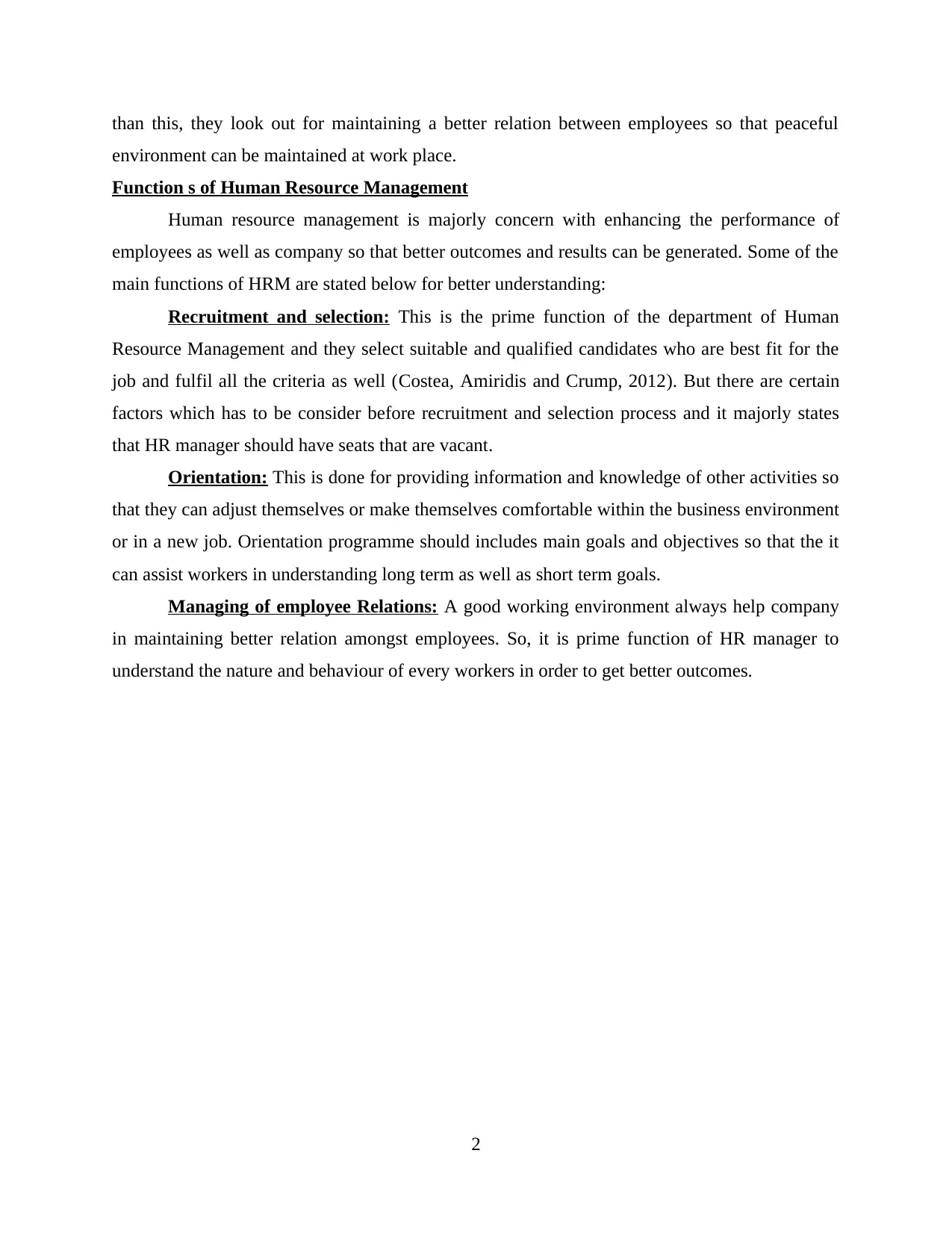
than this, they look out for maintaining a better relation between employees so that peaceful
environment can be maintained at work place.
Function s of Human Resource Management
Human resource management is majorly concern with enhancing the performance of
employees as well as company so that better outcomes and results can be generated. Some of the
main functions of HRM are stated below for better understanding:
Recruitment and selection: This is the prime function of the department of Human
Resource Management and they select suitable and qualified candidates who are best fit for the
job and fulfil all the criteria as well (Costea, Amiridis and Crump, 2012). But there are certain
factors which has to be consider before recruitment and selection process and it majorly states
that HR manager should have seats that are vacant.
Orientation: This is done for providing information and knowledge of other activities so
that they can adjust themselves or make themselves comfortable within the business environment
or in a new job. Orientation programme should includes main goals and objectives so that the it
can assist workers in understanding long term as well as short term goals.
Managing of employee Relations: A good working environment always help company
in maintaining better relation amongst employees. So, it is prime function of HR manager to
understand the nature and behaviour of every workers in order to get better outcomes.
2
environment can be maintained at work place.
Function s of Human Resource Management
Human resource management is majorly concern with enhancing the performance of
employees as well as company so that better outcomes and results can be generated. Some of the
main functions of HRM are stated below for better understanding:
Recruitment and selection: This is the prime function of the department of Human
Resource Management and they select suitable and qualified candidates who are best fit for the
job and fulfil all the criteria as well (Costea, Amiridis and Crump, 2012). But there are certain
factors which has to be consider before recruitment and selection process and it majorly states
that HR manager should have seats that are vacant.
Orientation: This is done for providing information and knowledge of other activities so
that they can adjust themselves or make themselves comfortable within the business environment
or in a new job. Orientation programme should includes main goals and objectives so that the it
can assist workers in understanding long term as well as short term goals.
Managing of employee Relations: A good working environment always help company
in maintaining better relation amongst employees. So, it is prime function of HR manager to
understand the nature and behaviour of every workers in order to get better outcomes.
2
Secure Best Marks with AI Grader
Need help grading? Try our AI Grader for instant feedback on your assignments.
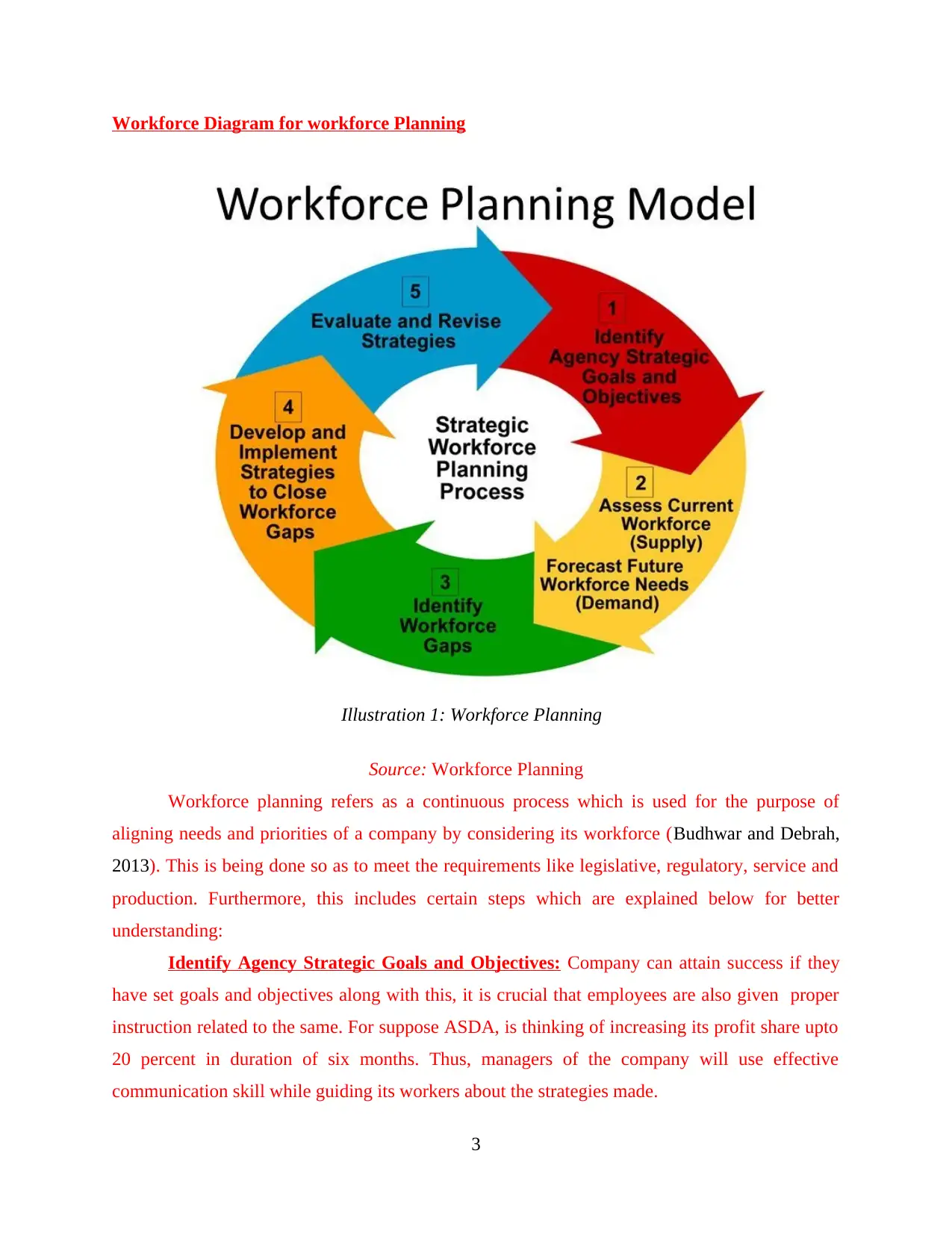
Workforce Diagram for workforce Planning
Source: Workforce Planning
Workforce planning refers as a continuous process which is used for the purpose of
aligning needs and priorities of a company by considering its workforce (Budhwar and Debrah,
2013). This is being done so as to meet the requirements like legislative, regulatory, service and
production. Furthermore, this includes certain steps which are explained below for better
understanding:
Identify Agency Strategic Goals and Objectives: Company can attain success if they
have set goals and objectives along with this, it is crucial that employees are also given proper
instruction related to the same. For suppose ASDA, is thinking of increasing its profit share upto
20 percent in duration of six months. Thus, managers of the company will use effective
communication skill while guiding its workers about the strategies made.
3
Illustration 1: Workforce Planning
Source: Workforce Planning
Workforce planning refers as a continuous process which is used for the purpose of
aligning needs and priorities of a company by considering its workforce (Budhwar and Debrah,
2013). This is being done so as to meet the requirements like legislative, regulatory, service and
production. Furthermore, this includes certain steps which are explained below for better
understanding:
Identify Agency Strategic Goals and Objectives: Company can attain success if they
have set goals and objectives along with this, it is crucial that employees are also given proper
instruction related to the same. For suppose ASDA, is thinking of increasing its profit share upto
20 percent in duration of six months. Thus, managers of the company will use effective
communication skill while guiding its workers about the strategies made.
3
Illustration 1: Workforce Planning
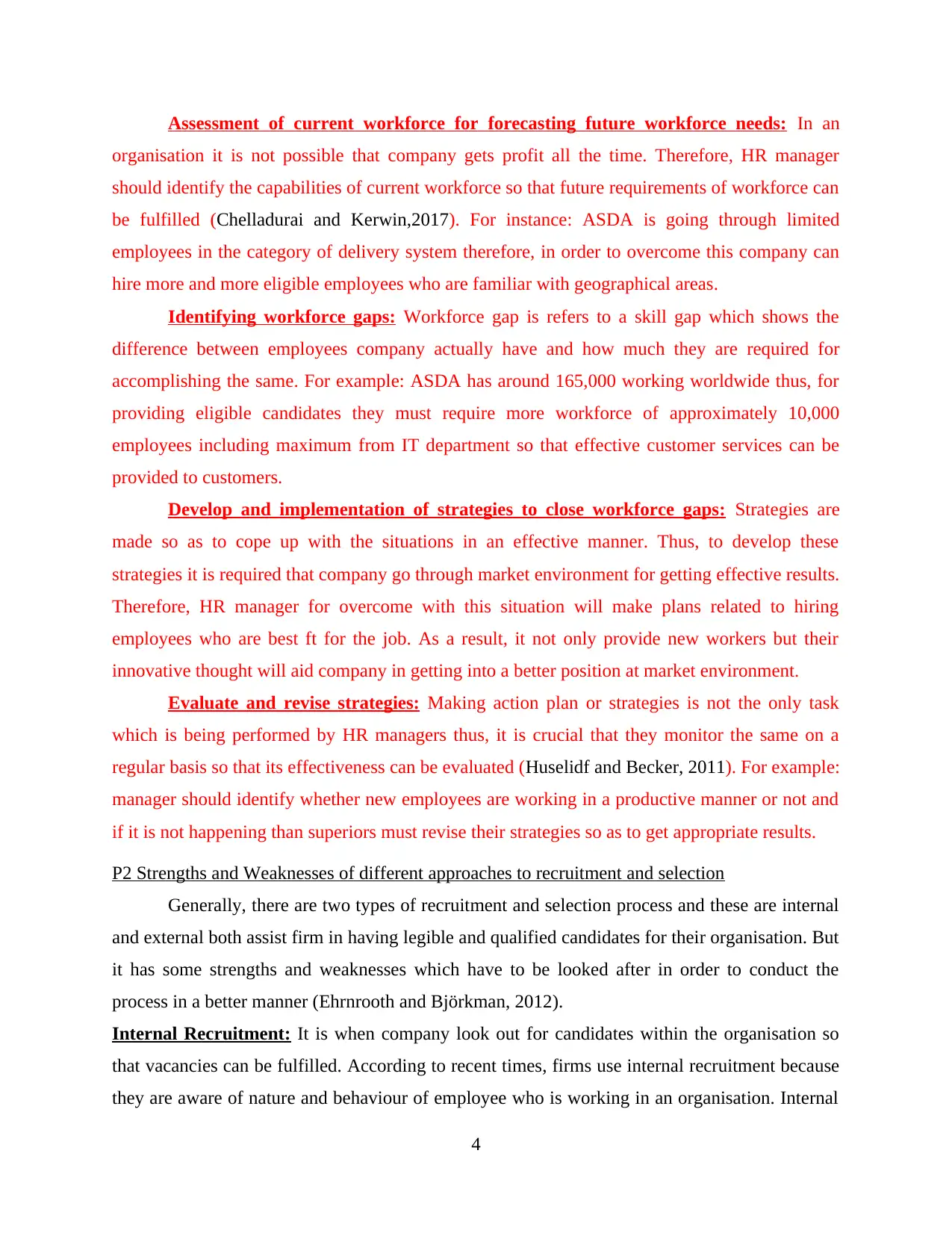
Assessment of current workforce for forecasting future workforce needs: In an
organisation it is not possible that company gets profit all the time. Therefore, HR manager
should identify the capabilities of current workforce so that future requirements of workforce can
be fulfilled (Chelladurai and Kerwin,2017). For instance: ASDA is going through limited
employees in the category of delivery system therefore, in order to overcome this company can
hire more and more eligible employees who are familiar with geographical areas.
Identifying workforce gaps: Workforce gap is refers to a skill gap which shows the
difference between employees company actually have and how much they are required for
accomplishing the same. For example: ASDA has around 165,000 working worldwide thus, for
providing eligible candidates they must require more workforce of approximately 10,000
employees including maximum from IT department so that effective customer services can be
provided to customers.
Develop and implementation of strategies to close workforce gaps: Strategies are
made so as to cope up with the situations in an effective manner. Thus, to develop these
strategies it is required that company go through market environment for getting effective results.
Therefore, HR manager for overcome with this situation will make plans related to hiring
employees who are best ft for the job. As a result, it not only provide new workers but their
innovative thought will aid company in getting into a better position at market environment.
Evaluate and revise strategies: Making action plan or strategies is not the only task
which is being performed by HR managers thus, it is crucial that they monitor the same on a
regular basis so that its effectiveness can be evaluated (Huselidf and Becker, 2011). For example:
manager should identify whether new employees are working in a productive manner or not and
if it is not happening than superiors must revise their strategies so as to get appropriate results.
P2 Strengths and Weaknesses of different approaches to recruitment and selection
Generally, there are two types of recruitment and selection process and these are internal
and external both assist firm in having legible and qualified candidates for their organisation. But
it has some strengths and weaknesses which have to be looked after in order to conduct the
process in a better manner (Ehrnrooth and Björkman, 2012).
Internal Recruitment: It is when company look out for candidates within the organisation so
that vacancies can be fulfilled. According to recent times, firms use internal recruitment because
they are aware of nature and behaviour of employee who is working in an organisation. Internal
4
organisation it is not possible that company gets profit all the time. Therefore, HR manager
should identify the capabilities of current workforce so that future requirements of workforce can
be fulfilled (Chelladurai and Kerwin,2017). For instance: ASDA is going through limited
employees in the category of delivery system therefore, in order to overcome this company can
hire more and more eligible employees who are familiar with geographical areas.
Identifying workforce gaps: Workforce gap is refers to a skill gap which shows the
difference between employees company actually have and how much they are required for
accomplishing the same. For example: ASDA has around 165,000 working worldwide thus, for
providing eligible candidates they must require more workforce of approximately 10,000
employees including maximum from IT department so that effective customer services can be
provided to customers.
Develop and implementation of strategies to close workforce gaps: Strategies are
made so as to cope up with the situations in an effective manner. Thus, to develop these
strategies it is required that company go through market environment for getting effective results.
Therefore, HR manager for overcome with this situation will make plans related to hiring
employees who are best ft for the job. As a result, it not only provide new workers but their
innovative thought will aid company in getting into a better position at market environment.
Evaluate and revise strategies: Making action plan or strategies is not the only task
which is being performed by HR managers thus, it is crucial that they monitor the same on a
regular basis so that its effectiveness can be evaluated (Huselidf and Becker, 2011). For example:
manager should identify whether new employees are working in a productive manner or not and
if it is not happening than superiors must revise their strategies so as to get appropriate results.
P2 Strengths and Weaknesses of different approaches to recruitment and selection
Generally, there are two types of recruitment and selection process and these are internal
and external both assist firm in having legible and qualified candidates for their organisation. But
it has some strengths and weaknesses which have to be looked after in order to conduct the
process in a better manner (Ehrnrooth and Björkman, 2012).
Internal Recruitment: It is when company look out for candidates within the organisation so
that vacancies can be fulfilled. According to recent times, firms use internal recruitment because
they are aware of nature and behaviour of employee who is working in an organisation. Internal
4
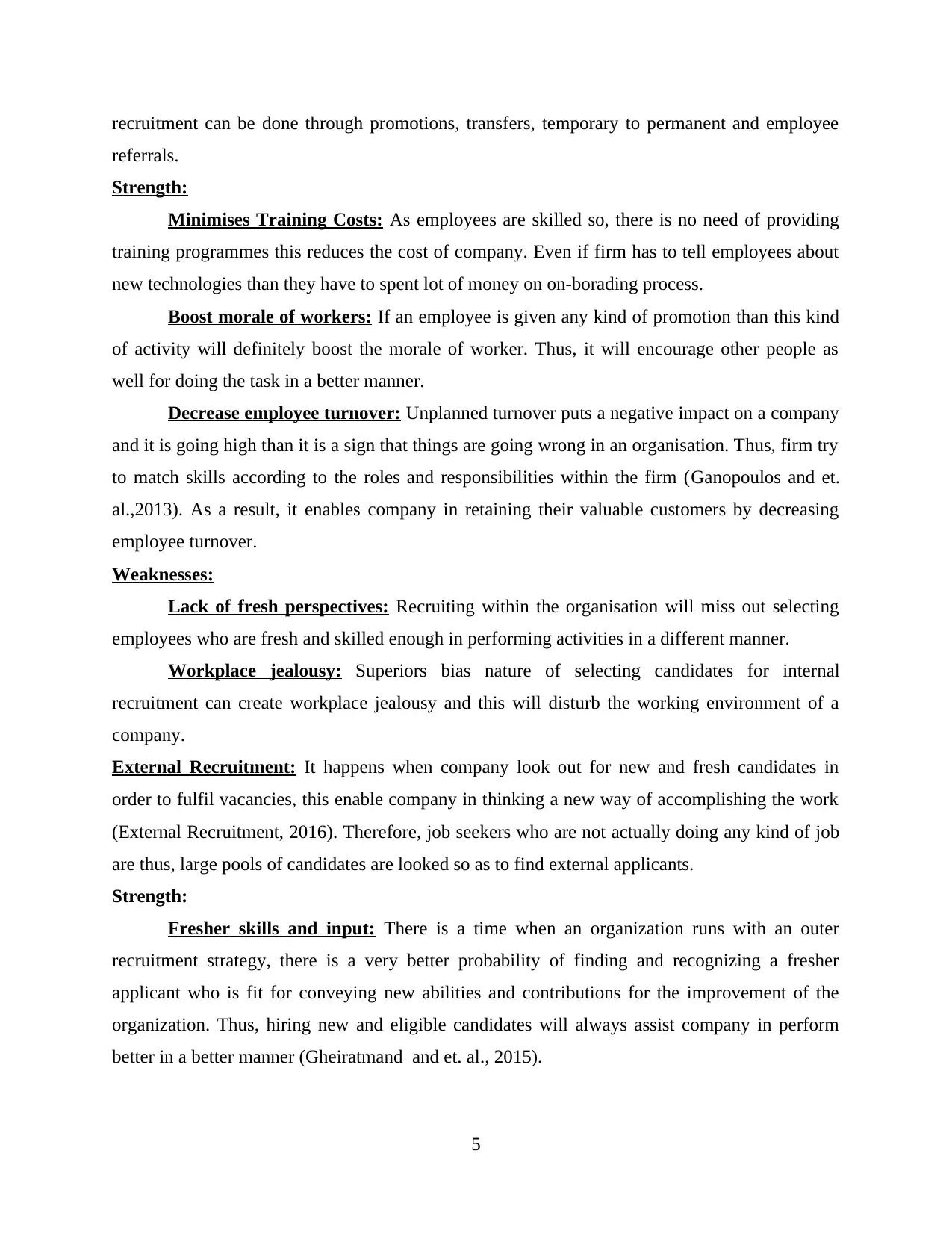
recruitment can be done through promotions, transfers, temporary to permanent and employee
referrals.
Strength:
Minimises Training Costs: As employees are skilled so, there is no need of providing
training programmes this reduces the cost of company. Even if firm has to tell employees about
new technologies than they have to spent lot of money on on-borading process.
Boost morale of workers: If an employee is given any kind of promotion than this kind
of activity will definitely boost the morale of worker. Thus, it will encourage other people as
well for doing the task in a better manner.
Decrease employee turnover: Unplanned turnover puts a negative impact on a company
and it is going high than it is a sign that things are going wrong in an organisation. Thus, firm try
to match skills according to the roles and responsibilities within the firm (Ganopoulos and et.
al.,2013). As a result, it enables company in retaining their valuable customers by decreasing
employee turnover.
Weaknesses:
Lack of fresh perspectives: Recruiting within the organisation will miss out selecting
employees who are fresh and skilled enough in performing activities in a different manner.
Workplace jealousy: Superiors bias nature of selecting candidates for internal
recruitment can create workplace jealousy and this will disturb the working environment of a
company.
External Recruitment: It happens when company look out for new and fresh candidates in
order to fulfil vacancies, this enable company in thinking a new way of accomplishing the work
(External Recruitment, 2016). Therefore, job seekers who are not actually doing any kind of job
are thus, large pools of candidates are looked so as to find external applicants.
Strength:
Fresher skills and input: There is a time when an organization runs with an outer
recruitment strategy, there is a very better probability of finding and recognizing a fresher
applicant who is fit for conveying new abilities and contributions for the improvement of the
organization. Thus, hiring new and eligible candidates will always assist company in perform
better in a better manner (Gheiratmand and et. al., 2015).
5
referrals.
Strength:
Minimises Training Costs: As employees are skilled so, there is no need of providing
training programmes this reduces the cost of company. Even if firm has to tell employees about
new technologies than they have to spent lot of money on on-borading process.
Boost morale of workers: If an employee is given any kind of promotion than this kind
of activity will definitely boost the morale of worker. Thus, it will encourage other people as
well for doing the task in a better manner.
Decrease employee turnover: Unplanned turnover puts a negative impact on a company
and it is going high than it is a sign that things are going wrong in an organisation. Thus, firm try
to match skills according to the roles and responsibilities within the firm (Ganopoulos and et.
al.,2013). As a result, it enables company in retaining their valuable customers by decreasing
employee turnover.
Weaknesses:
Lack of fresh perspectives: Recruiting within the organisation will miss out selecting
employees who are fresh and skilled enough in performing activities in a different manner.
Workplace jealousy: Superiors bias nature of selecting candidates for internal
recruitment can create workplace jealousy and this will disturb the working environment of a
company.
External Recruitment: It happens when company look out for new and fresh candidates in
order to fulfil vacancies, this enable company in thinking a new way of accomplishing the work
(External Recruitment, 2016). Therefore, job seekers who are not actually doing any kind of job
are thus, large pools of candidates are looked so as to find external applicants.
Strength:
Fresher skills and input: There is a time when an organization runs with an outer
recruitment strategy, there is a very better probability of finding and recognizing a fresher
applicant who is fit for conveying new abilities and contributions for the improvement of the
organization. Thus, hiring new and eligible candidates will always assist company in perform
better in a better manner (Gheiratmand and et. al., 2015).
5
Paraphrase This Document
Need a fresh take? Get an instant paraphrase of this document with our AI Paraphraser
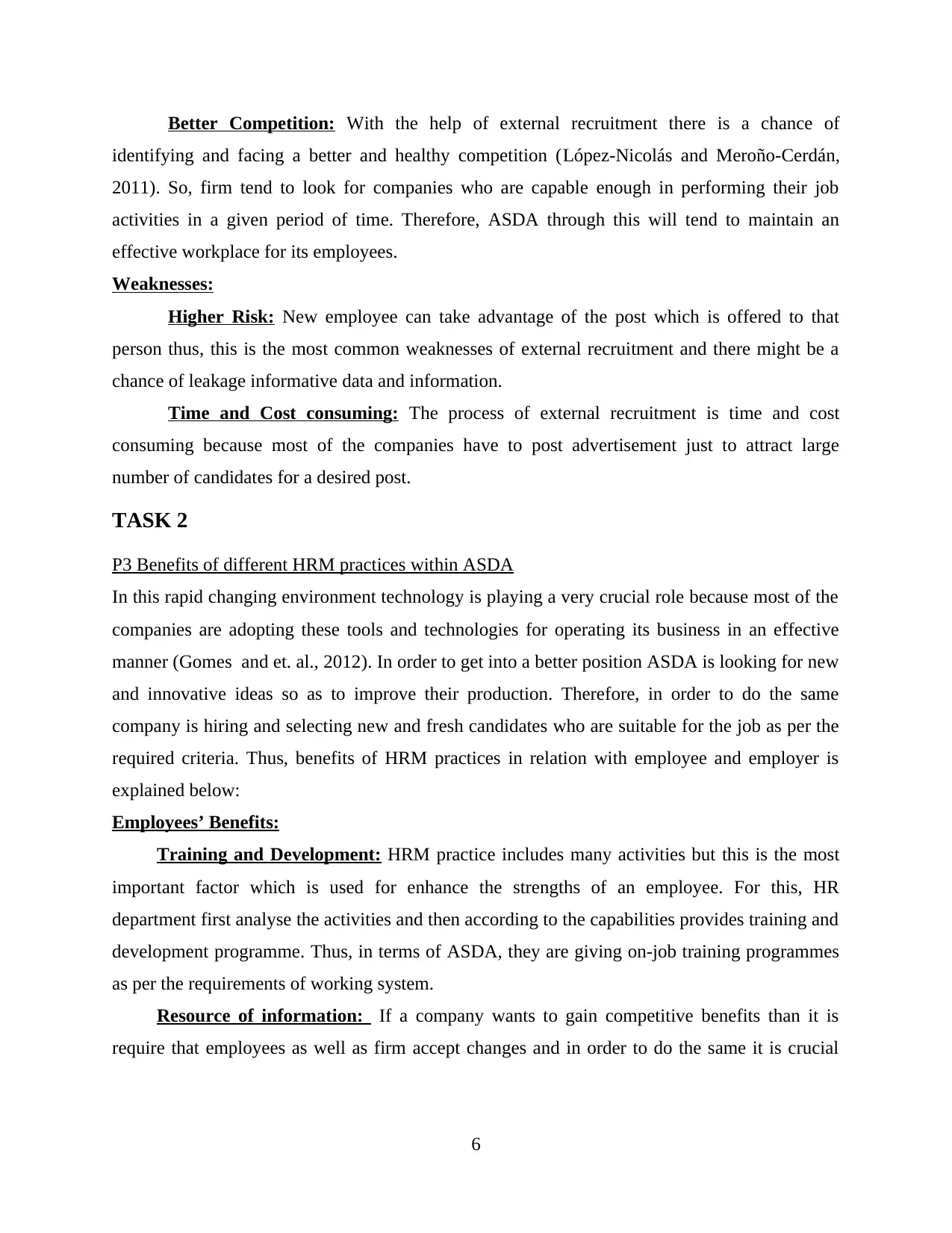
Better Competition: With the help of external recruitment there is a chance of
identifying and facing a better and healthy competition (López-Nicolás and Meroño-Cerdán,
2011). So, firm tend to look for companies who are capable enough in performing their job
activities in a given period of time. Therefore, ASDA through this will tend to maintain an
effective workplace for its employees.
Weaknesses:
Higher Risk: New employee can take advantage of the post which is offered to that
person thus, this is the most common weaknesses of external recruitment and there might be a
chance of leakage informative data and information.
Time and Cost consuming: The process of external recruitment is time and cost
consuming because most of the companies have to post advertisement just to attract large
number of candidates for a desired post.
TASK 2
P3 Benefits of different HRM practices within ASDA
In this rapid changing environment technology is playing a very crucial role because most of the
companies are adopting these tools and technologies for operating its business in an effective
manner (Gomes and et. al., 2012). In order to get into a better position ASDA is looking for new
and innovative ideas so as to improve their production. Therefore, in order to do the same
company is hiring and selecting new and fresh candidates who are suitable for the job as per the
required criteria. Thus, benefits of HRM practices in relation with employee and employer is
explained below:
Employees’ Benefits:
Training and Development: HRM practice includes many activities but this is the most
important factor which is used for enhance the strengths of an employee. For this, HR
department first analyse the activities and then according to the capabilities provides training and
development programme. Thus, in terms of ASDA, they are giving on-job training programmes
as per the requirements of working system.
Resource of information: If a company wants to gain competitive benefits than it is
require that employees as well as firm accept changes and in order to do the same it is crucial
6
identifying and facing a better and healthy competition (López-Nicolás and Meroño-Cerdán,
2011). So, firm tend to look for companies who are capable enough in performing their job
activities in a given period of time. Therefore, ASDA through this will tend to maintain an
effective workplace for its employees.
Weaknesses:
Higher Risk: New employee can take advantage of the post which is offered to that
person thus, this is the most common weaknesses of external recruitment and there might be a
chance of leakage informative data and information.
Time and Cost consuming: The process of external recruitment is time and cost
consuming because most of the companies have to post advertisement just to attract large
number of candidates for a desired post.
TASK 2
P3 Benefits of different HRM practices within ASDA
In this rapid changing environment technology is playing a very crucial role because most of the
companies are adopting these tools and technologies for operating its business in an effective
manner (Gomes and et. al., 2012). In order to get into a better position ASDA is looking for new
and innovative ideas so as to improve their production. Therefore, in order to do the same
company is hiring and selecting new and fresh candidates who are suitable for the job as per the
required criteria. Thus, benefits of HRM practices in relation with employee and employer is
explained below:
Employees’ Benefits:
Training and Development: HRM practice includes many activities but this is the most
important factor which is used for enhance the strengths of an employee. For this, HR
department first analyse the activities and then according to the capabilities provides training and
development programme. Thus, in terms of ASDA, they are giving on-job training programmes
as per the requirements of working system.
Resource of information: If a company wants to gain competitive benefits than it is
require that employees as well as firm accept changes and in order to do the same it is crucial
6
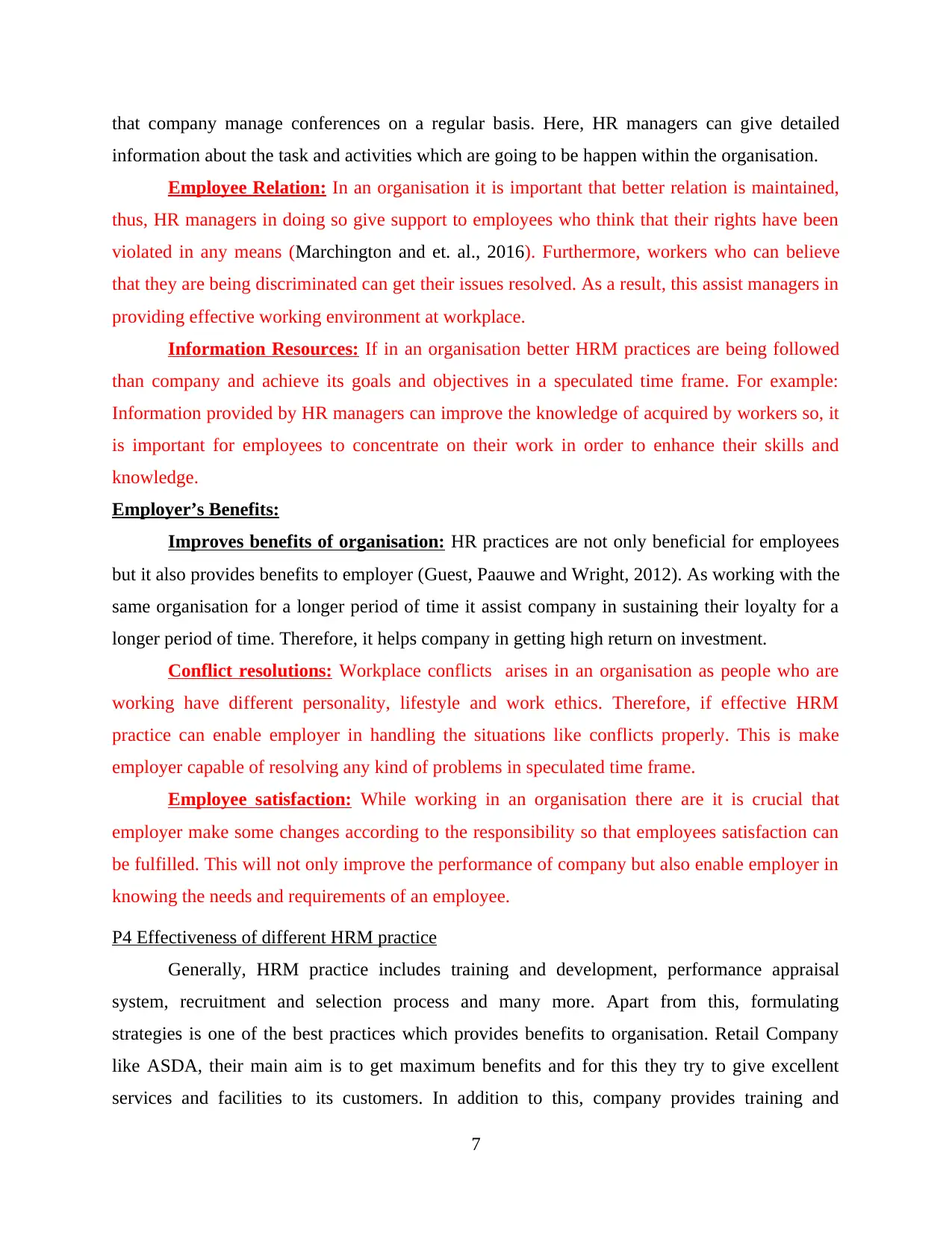
that company manage conferences on a regular basis. Here, HR managers can give detailed
information about the task and activities which are going to be happen within the organisation.
Employee Relation: In an organisation it is important that better relation is maintained,
thus, HR managers in doing so give support to employees who think that their rights have been
violated in any means (Marchington and et. al., 2016). Furthermore, workers who can believe
that they are being discriminated can get their issues resolved. As a result, this assist managers in
providing effective working environment at workplace.
Information Resources: If in an organisation better HRM practices are being followed
than company and achieve its goals and objectives in a speculated time frame. For example:
Information provided by HR managers can improve the knowledge of acquired by workers so, it
is important for employees to concentrate on their work in order to enhance their skills and
knowledge.
Employer’s Benefits:
Improves benefits of organisation: HR practices are not only beneficial for employees
but it also provides benefits to employer (Guest, Paauwe and Wright, 2012). As working with the
same organisation for a longer period of time it assist company in sustaining their loyalty for a
longer period of time. Therefore, it helps company in getting high return on investment.
Conflict resolutions: Workplace conflicts arises in an organisation as people who are
working have different personality, lifestyle and work ethics. Therefore, if effective HRM
practice can enable employer in handling the situations like conflicts properly. This is make
employer capable of resolving any kind of problems in speculated time frame.
Employee satisfaction: While working in an organisation there are it is crucial that
employer make some changes according to the responsibility so that employees satisfaction can
be fulfilled. This will not only improve the performance of company but also enable employer in
knowing the needs and requirements of an employee.
P4 Effectiveness of different HRM practice
Generally, HRM practice includes training and development, performance appraisal
system, recruitment and selection process and many more. Apart from this, formulating
strategies is one of the best practices which provides benefits to organisation. Retail Company
like ASDA, their main aim is to get maximum benefits and for this they try to give excellent
services and facilities to its customers. In addition to this, company provides training and
7
information about the task and activities which are going to be happen within the organisation.
Employee Relation: In an organisation it is important that better relation is maintained,
thus, HR managers in doing so give support to employees who think that their rights have been
violated in any means (Marchington and et. al., 2016). Furthermore, workers who can believe
that they are being discriminated can get their issues resolved. As a result, this assist managers in
providing effective working environment at workplace.
Information Resources: If in an organisation better HRM practices are being followed
than company and achieve its goals and objectives in a speculated time frame. For example:
Information provided by HR managers can improve the knowledge of acquired by workers so, it
is important for employees to concentrate on their work in order to enhance their skills and
knowledge.
Employer’s Benefits:
Improves benefits of organisation: HR practices are not only beneficial for employees
but it also provides benefits to employer (Guest, Paauwe and Wright, 2012). As working with the
same organisation for a longer period of time it assist company in sustaining their loyalty for a
longer period of time. Therefore, it helps company in getting high return on investment.
Conflict resolutions: Workplace conflicts arises in an organisation as people who are
working have different personality, lifestyle and work ethics. Therefore, if effective HRM
practice can enable employer in handling the situations like conflicts properly. This is make
employer capable of resolving any kind of problems in speculated time frame.
Employee satisfaction: While working in an organisation there are it is crucial that
employer make some changes according to the responsibility so that employees satisfaction can
be fulfilled. This will not only improve the performance of company but also enable employer in
knowing the needs and requirements of an employee.
P4 Effectiveness of different HRM practice
Generally, HRM practice includes training and development, performance appraisal
system, recruitment and selection process and many more. Apart from this, formulating
strategies is one of the best practices which provides benefits to organisation. Retail Company
like ASDA, their main aim is to get maximum benefits and for this they try to give excellent
services and facilities to its customers. In addition to this, company provides training and
7
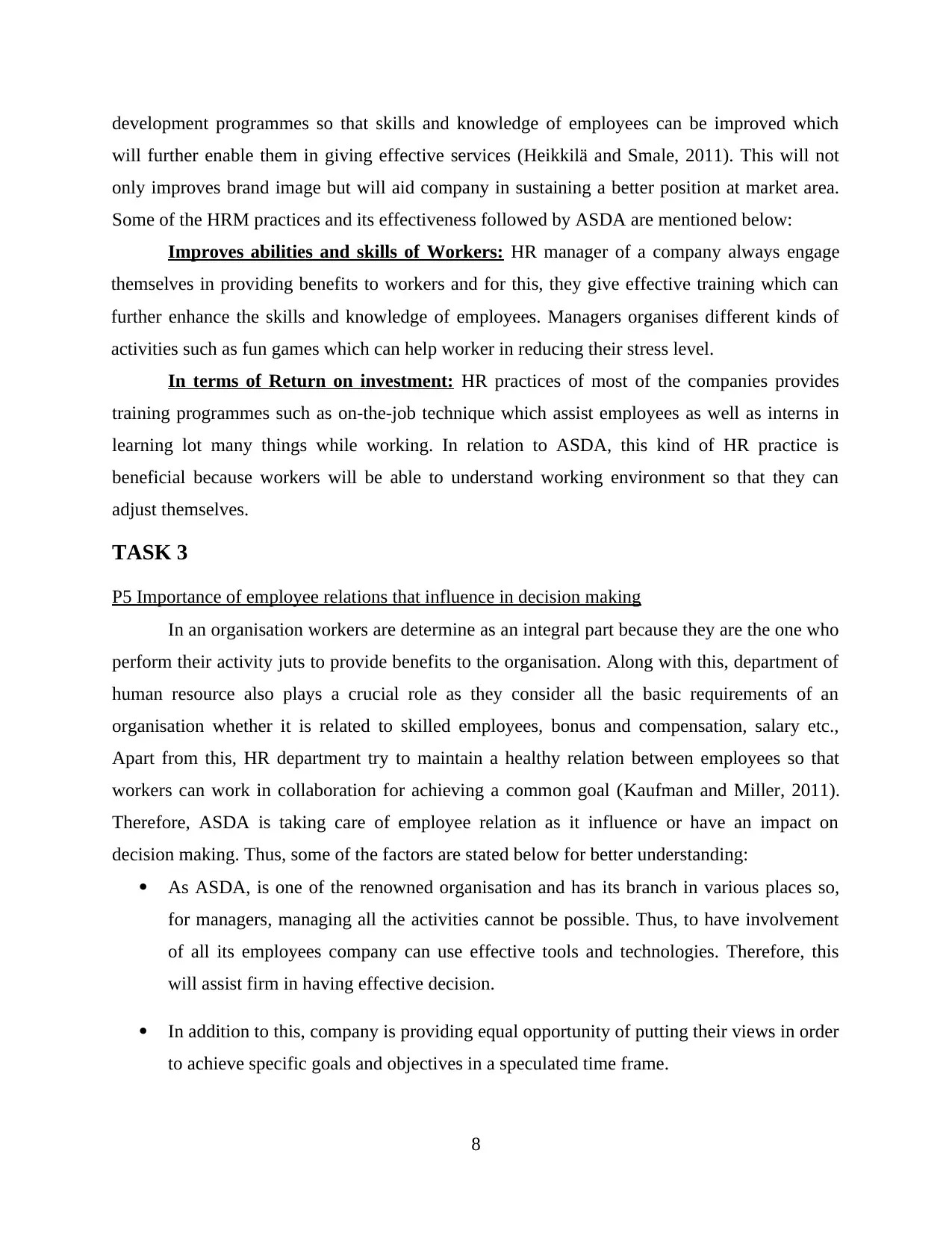
development programmes so that skills and knowledge of employees can be improved which
will further enable them in giving effective services (Heikkilä and Smale, 2011). This will not
only improves brand image but will aid company in sustaining a better position at market area.
Some of the HRM practices and its effectiveness followed by ASDA are mentioned below:
Improves abilities and skills of Workers: HR manager of a company always engage
themselves in providing benefits to workers and for this, they give effective training which can
further enhance the skills and knowledge of employees. Managers organises different kinds of
activities such as fun games which can help worker in reducing their stress level.
In terms of Return on investment: HR practices of most of the companies provides
training programmes such as on-the-job technique which assist employees as well as interns in
learning lot many things while working. In relation to ASDA, this kind of HR practice is
beneficial because workers will be able to understand working environment so that they can
adjust themselves.
TASK 3
P5 Importance of employee relations that influence in decision making
In an organisation workers are determine as an integral part because they are the one who
perform their activity juts to provide benefits to the organisation. Along with this, department of
human resource also plays a crucial role as they consider all the basic requirements of an
organisation whether it is related to skilled employees, bonus and compensation, salary etc.,
Apart from this, HR department try to maintain a healthy relation between employees so that
workers can work in collaboration for achieving a common goal (Kaufman and Miller, 2011).
Therefore, ASDA is taking care of employee relation as it influence or have an impact on
decision making. Thus, some of the factors are stated below for better understanding:
As ASDA, is one of the renowned organisation and has its branch in various places so,
for managers, managing all the activities cannot be possible. Thus, to have involvement
of all its employees company can use effective tools and technologies. Therefore, this
will assist firm in having effective decision.
In addition to this, company is providing equal opportunity of putting their views in order
to achieve specific goals and objectives in a speculated time frame.
8
will further enable them in giving effective services (Heikkilä and Smale, 2011). This will not
only improves brand image but will aid company in sustaining a better position at market area.
Some of the HRM practices and its effectiveness followed by ASDA are mentioned below:
Improves abilities and skills of Workers: HR manager of a company always engage
themselves in providing benefits to workers and for this, they give effective training which can
further enhance the skills and knowledge of employees. Managers organises different kinds of
activities such as fun games which can help worker in reducing their stress level.
In terms of Return on investment: HR practices of most of the companies provides
training programmes such as on-the-job technique which assist employees as well as interns in
learning lot many things while working. In relation to ASDA, this kind of HR practice is
beneficial because workers will be able to understand working environment so that they can
adjust themselves.
TASK 3
P5 Importance of employee relations that influence in decision making
In an organisation workers are determine as an integral part because they are the one who
perform their activity juts to provide benefits to the organisation. Along with this, department of
human resource also plays a crucial role as they consider all the basic requirements of an
organisation whether it is related to skilled employees, bonus and compensation, salary etc.,
Apart from this, HR department try to maintain a healthy relation between employees so that
workers can work in collaboration for achieving a common goal (Kaufman and Miller, 2011).
Therefore, ASDA is taking care of employee relation as it influence or have an impact on
decision making. Thus, some of the factors are stated below for better understanding:
As ASDA, is one of the renowned organisation and has its branch in various places so,
for managers, managing all the activities cannot be possible. Thus, to have involvement
of all its employees company can use effective tools and technologies. Therefore, this
will assist firm in having effective decision.
In addition to this, company is providing equal opportunity of putting their views in order
to achieve specific goals and objectives in a speculated time frame.
8
Secure Best Marks with AI Grader
Need help grading? Try our AI Grader for instant feedback on your assignments.
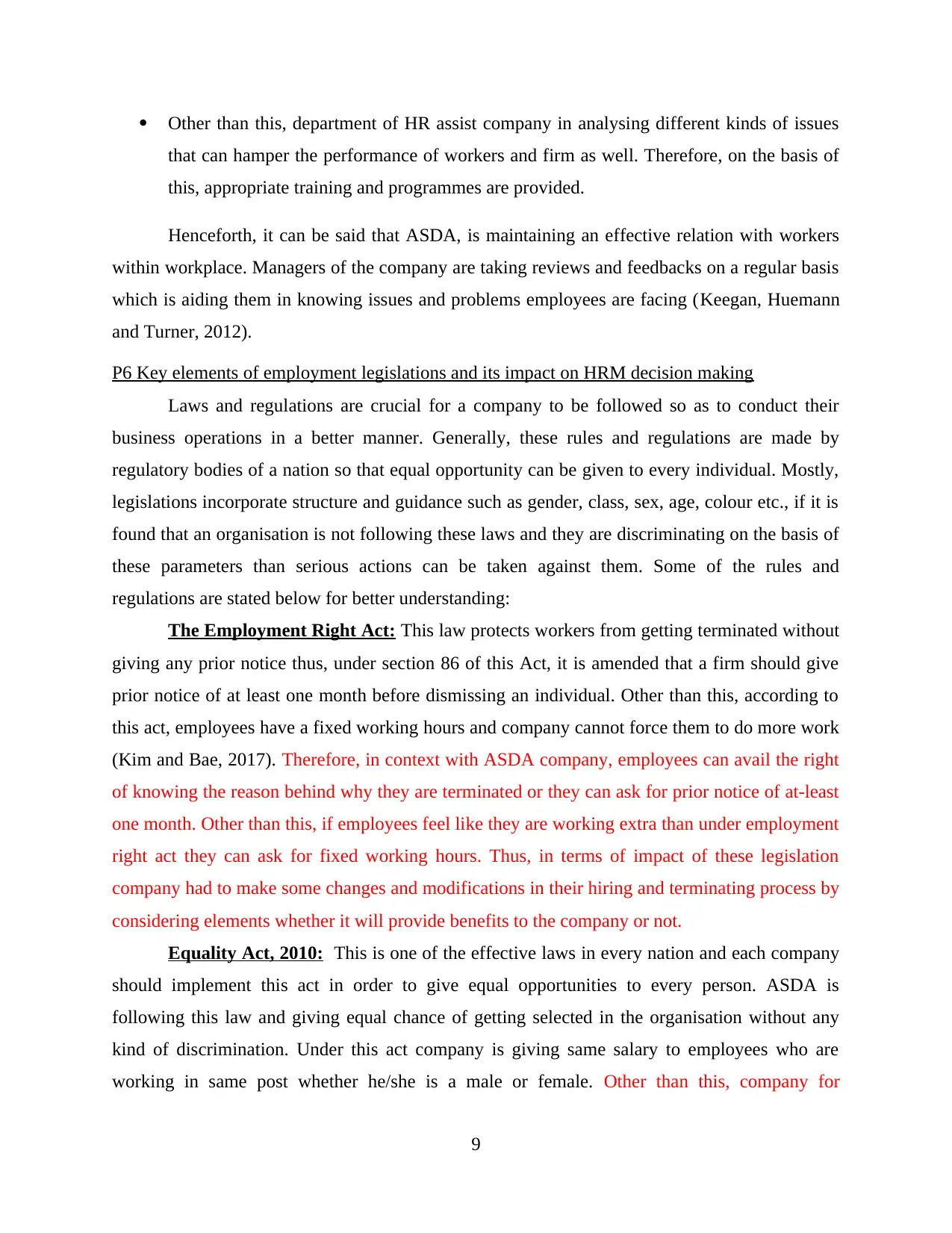
Other than this, department of HR assist company in analysing different kinds of issues
that can hamper the performance of workers and firm as well. Therefore, on the basis of
this, appropriate training and programmes are provided.
Henceforth, it can be said that ASDA, is maintaining an effective relation with workers
within workplace. Managers of the company are taking reviews and feedbacks on a regular basis
which is aiding them in knowing issues and problems employees are facing (Keegan, Huemann
and Turner, 2012).
P6 Key elements of employment legislations and its impact on HRM decision making
Laws and regulations are crucial for a company to be followed so as to conduct their
business operations in a better manner. Generally, these rules and regulations are made by
regulatory bodies of a nation so that equal opportunity can be given to every individual. Mostly,
legislations incorporate structure and guidance such as gender, class, sex, age, colour etc., if it is
found that an organisation is not following these laws and they are discriminating on the basis of
these parameters than serious actions can be taken against them. Some of the rules and
regulations are stated below for better understanding:
The Employment Right Act: This law protects workers from getting terminated without
giving any prior notice thus, under section 86 of this Act, it is amended that a firm should give
prior notice of at least one month before dismissing an individual. Other than this, according to
this act, employees have a fixed working hours and company cannot force them to do more work
(Kim and Bae, 2017). Therefore, in context with ASDA company, employees can avail the right
of knowing the reason behind why they are terminated or they can ask for prior notice of at-least
one month. Other than this, if employees feel like they are working extra than under employment
right act they can ask for fixed working hours. Thus, in terms of impact of these legislation
company had to make some changes and modifications in their hiring and terminating process by
considering elements whether it will provide benefits to the company or not.
Equality Act, 2010: This is one of the effective laws in every nation and each company
should implement this act in order to give equal opportunities to every person. ASDA is
following this law and giving equal chance of getting selected in the organisation without any
kind of discrimination. Under this act company is giving same salary to employees who are
working in same post whether he/she is a male or female. Other than this, company for
9
that can hamper the performance of workers and firm as well. Therefore, on the basis of
this, appropriate training and programmes are provided.
Henceforth, it can be said that ASDA, is maintaining an effective relation with workers
within workplace. Managers of the company are taking reviews and feedbacks on a regular basis
which is aiding them in knowing issues and problems employees are facing (Keegan, Huemann
and Turner, 2012).
P6 Key elements of employment legislations and its impact on HRM decision making
Laws and regulations are crucial for a company to be followed so as to conduct their
business operations in a better manner. Generally, these rules and regulations are made by
regulatory bodies of a nation so that equal opportunity can be given to every individual. Mostly,
legislations incorporate structure and guidance such as gender, class, sex, age, colour etc., if it is
found that an organisation is not following these laws and they are discriminating on the basis of
these parameters than serious actions can be taken against them. Some of the rules and
regulations are stated below for better understanding:
The Employment Right Act: This law protects workers from getting terminated without
giving any prior notice thus, under section 86 of this Act, it is amended that a firm should give
prior notice of at least one month before dismissing an individual. Other than this, according to
this act, employees have a fixed working hours and company cannot force them to do more work
(Kim and Bae, 2017). Therefore, in context with ASDA company, employees can avail the right
of knowing the reason behind why they are terminated or they can ask for prior notice of at-least
one month. Other than this, if employees feel like they are working extra than under employment
right act they can ask for fixed working hours. Thus, in terms of impact of these legislation
company had to make some changes and modifications in their hiring and terminating process by
considering elements whether it will provide benefits to the company or not.
Equality Act, 2010: This is one of the effective laws in every nation and each company
should implement this act in order to give equal opportunities to every person. ASDA is
following this law and giving equal chance of getting selected in the organisation without any
kind of discrimination. Under this act company is giving same salary to employees who are
working in same post whether he/she is a male or female. Other than this, company for
9
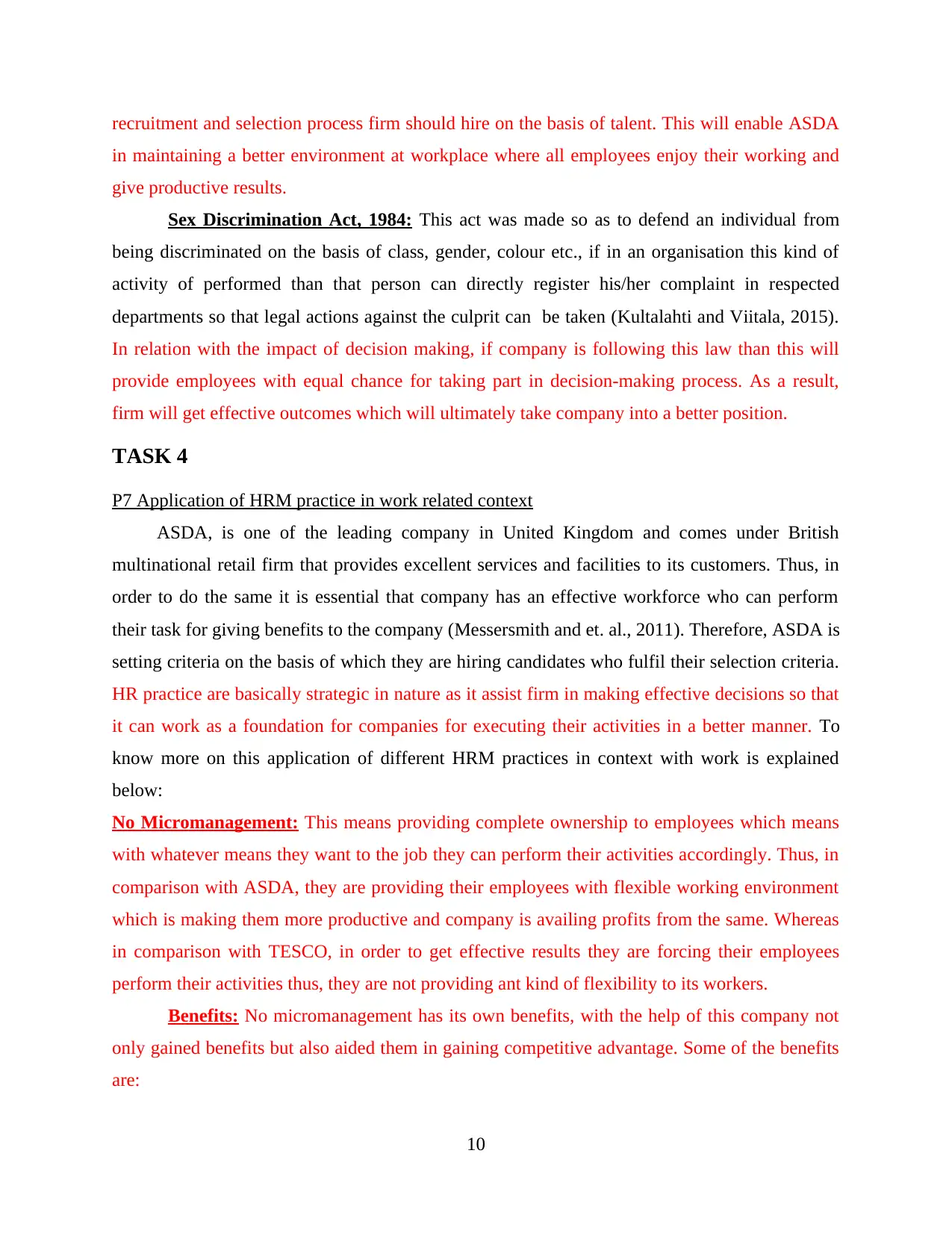
recruitment and selection process firm should hire on the basis of talent. This will enable ASDA
in maintaining a better environment at workplace where all employees enjoy their working and
give productive results.
Sex Discrimination Act, 1984: This act was made so as to defend an individual from
being discriminated on the basis of class, gender, colour etc., if in an organisation this kind of
activity of performed than that person can directly register his/her complaint in respected
departments so that legal actions against the culprit can be taken (Kultalahti and Viitala, 2015).
In relation with the impact of decision making, if company is following this law than this will
provide employees with equal chance for taking part in decision-making process. As a result,
firm will get effective outcomes which will ultimately take company into a better position.
TASK 4
P7 Application of HRM practice in work related context
ASDA, is one of the leading company in United Kingdom and comes under British
multinational retail firm that provides excellent services and facilities to its customers. Thus, in
order to do the same it is essential that company has an effective workforce who can perform
their task for giving benefits to the company (Messersmith and et. al., 2011). Therefore, ASDA is
setting criteria on the basis of which they are hiring candidates who fulfil their selection criteria.
HR practice are basically strategic in nature as it assist firm in making effective decisions so that
it can work as a foundation for companies for executing their activities in a better manner. To
know more on this application of different HRM practices in context with work is explained
below:
No Micromanagement: This means providing complete ownership to employees which means
with whatever means they want to the job they can perform their activities accordingly. Thus, in
comparison with ASDA, they are providing their employees with flexible working environment
which is making them more productive and company is availing profits from the same. Whereas
in comparison with TESCO, in order to get effective results they are forcing their employees
perform their activities thus, they are not providing ant kind of flexibility to its workers.
Benefits: No micromanagement has its own benefits, with the help of this company not
only gained benefits but also aided them in gaining competitive advantage. Some of the benefits
are:
10
in maintaining a better environment at workplace where all employees enjoy their working and
give productive results.
Sex Discrimination Act, 1984: This act was made so as to defend an individual from
being discriminated on the basis of class, gender, colour etc., if in an organisation this kind of
activity of performed than that person can directly register his/her complaint in respected
departments so that legal actions against the culprit can be taken (Kultalahti and Viitala, 2015).
In relation with the impact of decision making, if company is following this law than this will
provide employees with equal chance for taking part in decision-making process. As a result,
firm will get effective outcomes which will ultimately take company into a better position.
TASK 4
P7 Application of HRM practice in work related context
ASDA, is one of the leading company in United Kingdom and comes under British
multinational retail firm that provides excellent services and facilities to its customers. Thus, in
order to do the same it is essential that company has an effective workforce who can perform
their task for giving benefits to the company (Messersmith and et. al., 2011). Therefore, ASDA is
setting criteria on the basis of which they are hiring candidates who fulfil their selection criteria.
HR practice are basically strategic in nature as it assist firm in making effective decisions so that
it can work as a foundation for companies for executing their activities in a better manner. To
know more on this application of different HRM practices in context with work is explained
below:
No Micromanagement: This means providing complete ownership to employees which means
with whatever means they want to the job they can perform their activities accordingly. Thus, in
comparison with ASDA, they are providing their employees with flexible working environment
which is making them more productive and company is availing profits from the same. Whereas
in comparison with TESCO, in order to get effective results they are forcing their employees
perform their activities thus, they are not providing ant kind of flexibility to its workers.
Benefits: No micromanagement has its own benefits, with the help of this company not
only gained benefits but also aided them in gaining competitive advantage. Some of the benefits
are:
10
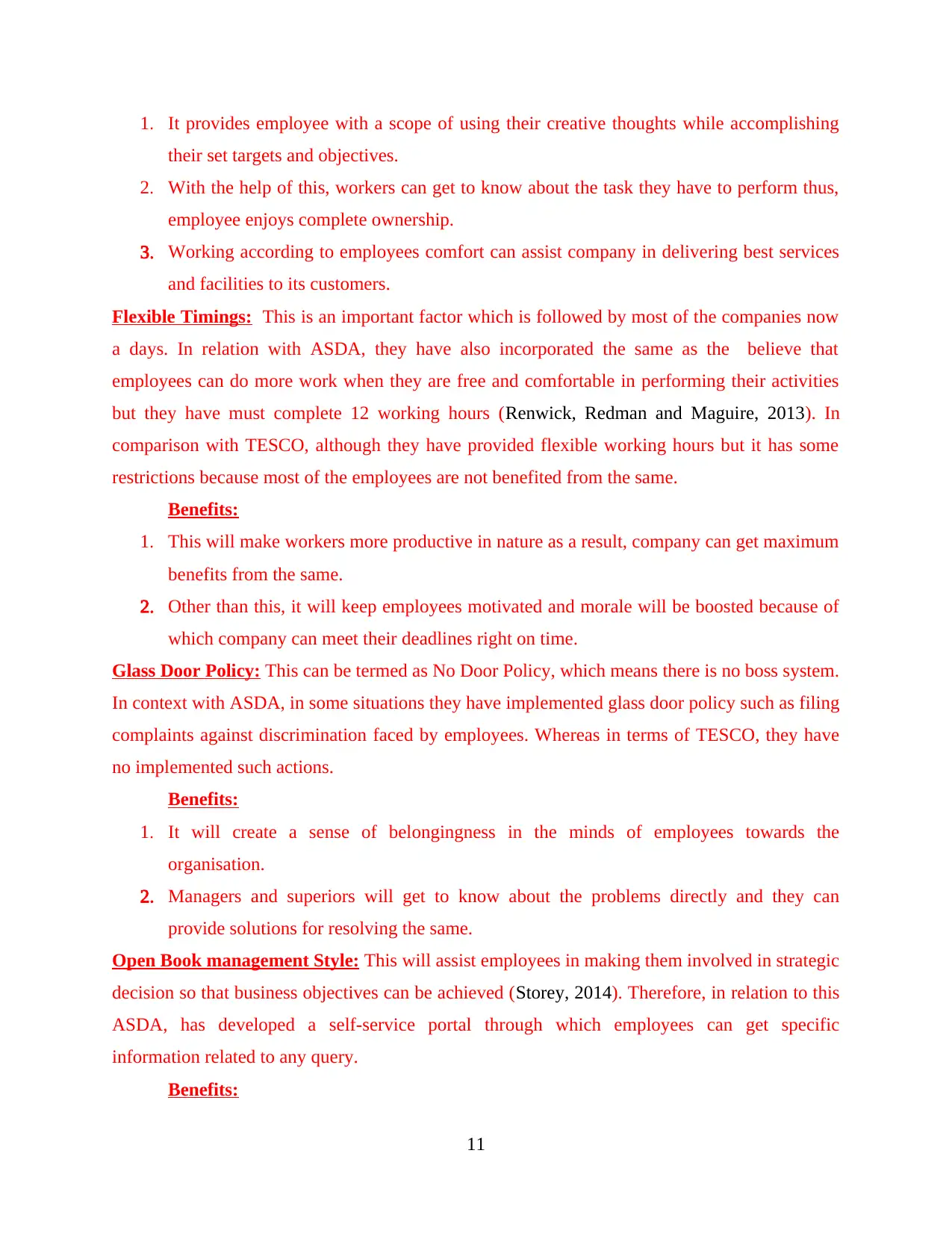
1. It provides employee with a scope of using their creative thoughts while accomplishing
their set targets and objectives.
2. With the help of this, workers can get to know about the task they have to perform thus,
employee enjoys complete ownership.
3. Working according to employees comfort can assist company in delivering best services
and facilities to its customers.
Flexible Timings: This is an important factor which is followed by most of the companies now
a days. In relation with ASDA, they have also incorporated the same as the believe that
employees can do more work when they are free and comfortable in performing their activities
but they have must complete 12 working hours (Renwick, Redman and Maguire, 2013). In
comparison with TESCO, although they have provided flexible working hours but it has some
restrictions because most of the employees are not benefited from the same.
Benefits:
1. This will make workers more productive in nature as a result, company can get maximum
benefits from the same.
2. Other than this, it will keep employees motivated and morale will be boosted because of
which company can meet their deadlines right on time.
Glass Door Policy: This can be termed as No Door Policy, which means there is no boss system.
In context with ASDA, in some situations they have implemented glass door policy such as filing
complaints against discrimination faced by employees. Whereas in terms of TESCO, they have
no implemented such actions.
Benefits:
1. It will create a sense of belongingness in the minds of employees towards the
organisation.
2. Managers and superiors will get to know about the problems directly and they can
provide solutions for resolving the same.
Open Book management Style: This will assist employees in making them involved in strategic
decision so that business objectives can be achieved (Storey, 2014). Therefore, in relation to this
ASDA, has developed a self-service portal through which employees can get specific
information related to any query.
Benefits:
11
their set targets and objectives.
2. With the help of this, workers can get to know about the task they have to perform thus,
employee enjoys complete ownership.
3. Working according to employees comfort can assist company in delivering best services
and facilities to its customers.
Flexible Timings: This is an important factor which is followed by most of the companies now
a days. In relation with ASDA, they have also incorporated the same as the believe that
employees can do more work when they are free and comfortable in performing their activities
but they have must complete 12 working hours (Renwick, Redman and Maguire, 2013). In
comparison with TESCO, although they have provided flexible working hours but it has some
restrictions because most of the employees are not benefited from the same.
Benefits:
1. This will make workers more productive in nature as a result, company can get maximum
benefits from the same.
2. Other than this, it will keep employees motivated and morale will be boosted because of
which company can meet their deadlines right on time.
Glass Door Policy: This can be termed as No Door Policy, which means there is no boss system.
In context with ASDA, in some situations they have implemented glass door policy such as filing
complaints against discrimination faced by employees. Whereas in terms of TESCO, they have
no implemented such actions.
Benefits:
1. It will create a sense of belongingness in the minds of employees towards the
organisation.
2. Managers and superiors will get to know about the problems directly and they can
provide solutions for resolving the same.
Open Book management Style: This will assist employees in making them involved in strategic
decision so that business objectives can be achieved (Storey, 2014). Therefore, in relation to this
ASDA, has developed a self-service portal through which employees can get specific
information related to any query.
Benefits:
11
Paraphrase This Document
Need a fresh take? Get an instant paraphrase of this document with our AI Paraphraser
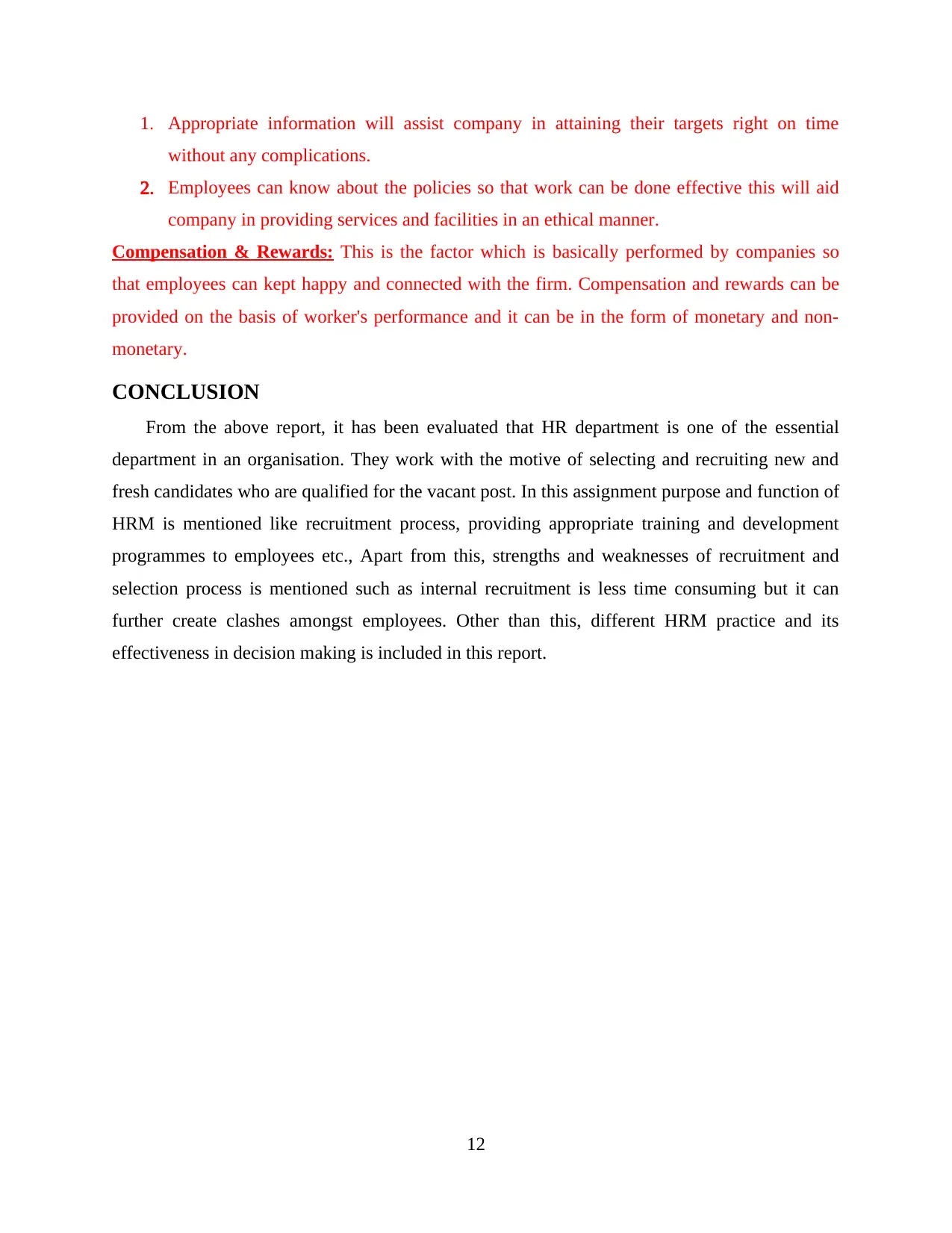
1. Appropriate information will assist company in attaining their targets right on time
without any complications.
2. Employees can know about the policies so that work can be done effective this will aid
company in providing services and facilities in an ethical manner.
Compensation & Rewards: This is the factor which is basically performed by companies so
that employees can kept happy and connected with the firm. Compensation and rewards can be
provided on the basis of worker's performance and it can be in the form of monetary and non-
monetary.
CONCLUSION
From the above report, it has been evaluated that HR department is one of the essential
department in an organisation. They work with the motive of selecting and recruiting new and
fresh candidates who are qualified for the vacant post. In this assignment purpose and function of
HRM is mentioned like recruitment process, providing appropriate training and development
programmes to employees etc., Apart from this, strengths and weaknesses of recruitment and
selection process is mentioned such as internal recruitment is less time consuming but it can
further create clashes amongst employees. Other than this, different HRM practice and its
effectiveness in decision making is included in this report.
12
without any complications.
2. Employees can know about the policies so that work can be done effective this will aid
company in providing services and facilities in an ethical manner.
Compensation & Rewards: This is the factor which is basically performed by companies so
that employees can kept happy and connected with the firm. Compensation and rewards can be
provided on the basis of worker's performance and it can be in the form of monetary and non-
monetary.
CONCLUSION
From the above report, it has been evaluated that HR department is one of the essential
department in an organisation. They work with the motive of selecting and recruiting new and
fresh candidates who are qualified for the vacant post. In this assignment purpose and function of
HRM is mentioned like recruitment process, providing appropriate training and development
programmes to employees etc., Apart from this, strengths and weaknesses of recruitment and
selection process is mentioned such as internal recruitment is less time consuming but it can
further create clashes amongst employees. Other than this, different HRM practice and its
effectiveness in decision making is included in this report.
12
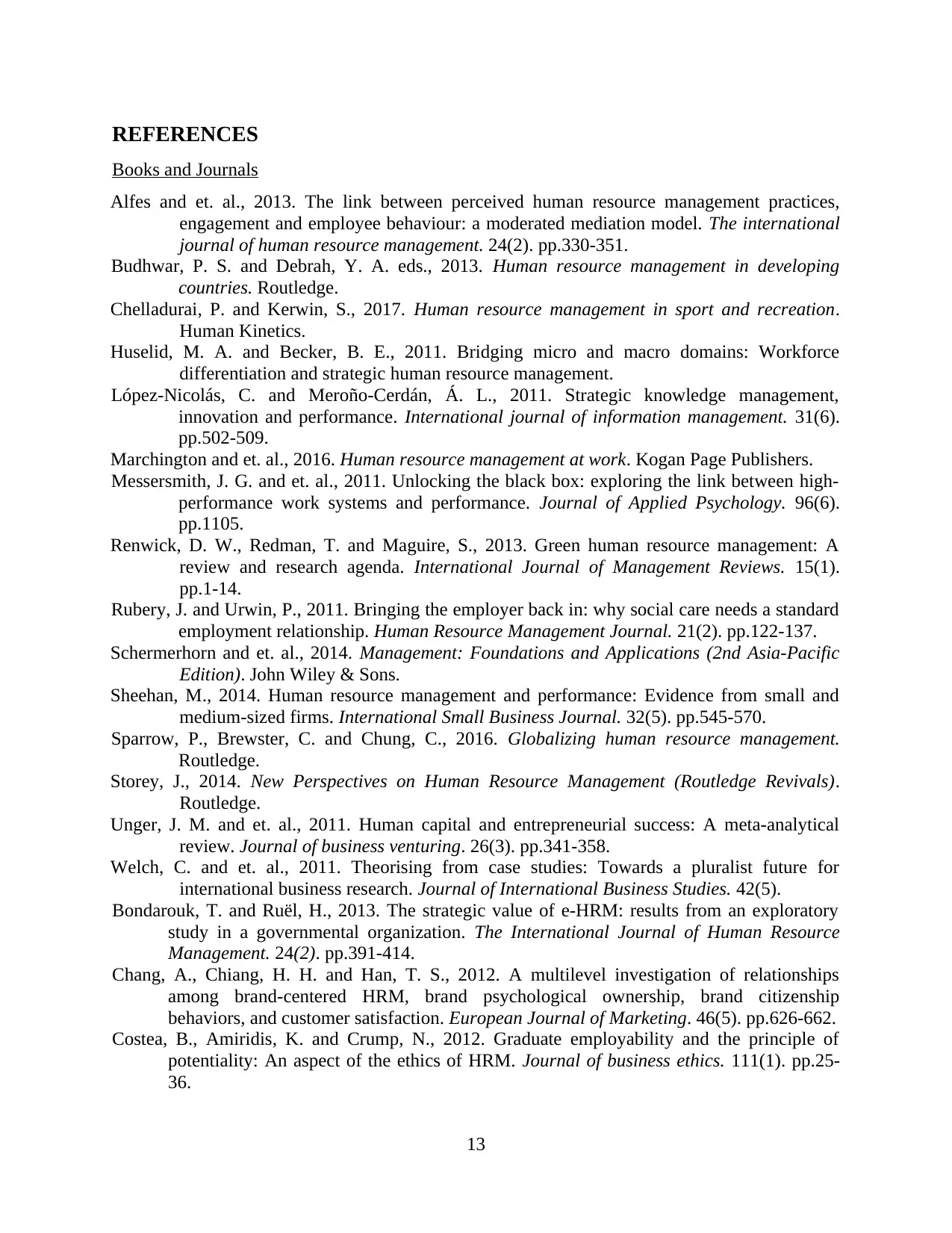
REFERENCES
Books and Journals
Alfes and et. al., 2013. The link between perceived human resource management practices,
engagement and employee behaviour: a moderated mediation model. The international
journal of human resource management. 24(2). pp.330-351.
Budhwar, P. S. and Debrah, Y. A. eds., 2013. Human resource management in developing
countries. Routledge.
Chelladurai, P. and Kerwin, S., 2017. Human resource management in sport and recreation.
Human Kinetics.
Huselid, M. A. and Becker, B. E., 2011. Bridging micro and macro domains: Workforce
differentiation and strategic human resource management.
López-Nicolás, C. and Meroño-Cerdán, Á. L., 2011. Strategic knowledge management,
innovation and performance. International journal of information management. 31(6).
pp.502-509.
Marchington and et. al., 2016. Human resource management at work. Kogan Page Publishers.
Messersmith, J. G. and et. al., 2011. Unlocking the black box: exploring the link between high-
performance work systems and performance. Journal of Applied Psychology. 96(6).
pp.1105.
Renwick, D. W., Redman, T. and Maguire, S., 2013. Green human resource management: A
review and research agenda. International Journal of Management Reviews. 15(1).
pp.1-14.
Rubery, J. and Urwin, P., 2011. Bringing the employer back in: why social care needs a standard
employment relationship. Human Resource Management Journal. 21(2). pp.122-137.
Schermerhorn and et. al., 2014. Management: Foundations and Applications (2nd Asia-Pacific
Edition). John Wiley & Sons.
Sheehan, M., 2014. Human resource management and performance: Evidence from small and
medium-sized firms. International Small Business Journal. 32(5). pp.545-570.
Sparrow, P., Brewster, C. and Chung, C., 2016. Globalizing human resource management.
Routledge.
Storey, J., 2014. New Perspectives on Human Resource Management (Routledge Revivals).
Routledge.
Unger, J. M. and et. al., 2011. Human capital and entrepreneurial success: A meta-analytical
review. Journal of business venturing. 26(3). pp.341-358.
Welch, C. and et. al., 2011. Theorising from case studies: Towards a pluralist future for
international business research. Journal of International Business Studies. 42(5).
Bondarouk, T. and Ruël, H., 2013. The strategic value of e-HRM: results from an exploratory
study in a governmental organization. The International Journal of Human Resource
Management. 24(2). pp.391-414.
Chang, A., Chiang, H. H. and Han, T. S., 2012. A multilevel investigation of relationships
among brand-centered HRM, brand psychological ownership, brand citizenship
behaviors, and customer satisfaction. European Journal of Marketing. 46(5). pp.626-662.
Costea, B., Amiridis, K. and Crump, N., 2012. Graduate employability and the principle of
potentiality: An aspect of the ethics of HRM. Journal of business ethics. 111(1). pp.25-
36.
13
Books and Journals
Alfes and et. al., 2013. The link between perceived human resource management practices,
engagement and employee behaviour: a moderated mediation model. The international
journal of human resource management. 24(2). pp.330-351.
Budhwar, P. S. and Debrah, Y. A. eds., 2013. Human resource management in developing
countries. Routledge.
Chelladurai, P. and Kerwin, S., 2017. Human resource management in sport and recreation.
Human Kinetics.
Huselid, M. A. and Becker, B. E., 2011. Bridging micro and macro domains: Workforce
differentiation and strategic human resource management.
López-Nicolás, C. and Meroño-Cerdán, Á. L., 2011. Strategic knowledge management,
innovation and performance. International journal of information management. 31(6).
pp.502-509.
Marchington and et. al., 2016. Human resource management at work. Kogan Page Publishers.
Messersmith, J. G. and et. al., 2011. Unlocking the black box: exploring the link between high-
performance work systems and performance. Journal of Applied Psychology. 96(6).
pp.1105.
Renwick, D. W., Redman, T. and Maguire, S., 2013. Green human resource management: A
review and research agenda. International Journal of Management Reviews. 15(1).
pp.1-14.
Rubery, J. and Urwin, P., 2011. Bringing the employer back in: why social care needs a standard
employment relationship. Human Resource Management Journal. 21(2). pp.122-137.
Schermerhorn and et. al., 2014. Management: Foundations and Applications (2nd Asia-Pacific
Edition). John Wiley & Sons.
Sheehan, M., 2014. Human resource management and performance: Evidence from small and
medium-sized firms. International Small Business Journal. 32(5). pp.545-570.
Sparrow, P., Brewster, C. and Chung, C., 2016. Globalizing human resource management.
Routledge.
Storey, J., 2014. New Perspectives on Human Resource Management (Routledge Revivals).
Routledge.
Unger, J. M. and et. al., 2011. Human capital and entrepreneurial success: A meta-analytical
review. Journal of business venturing. 26(3). pp.341-358.
Welch, C. and et. al., 2011. Theorising from case studies: Towards a pluralist future for
international business research. Journal of International Business Studies. 42(5).
Bondarouk, T. and Ruël, H., 2013. The strategic value of e-HRM: results from an exploratory
study in a governmental organization. The International Journal of Human Resource
Management. 24(2). pp.391-414.
Chang, A., Chiang, H. H. and Han, T. S., 2012. A multilevel investigation of relationships
among brand-centered HRM, brand psychological ownership, brand citizenship
behaviors, and customer satisfaction. European Journal of Marketing. 46(5). pp.626-662.
Costea, B., Amiridis, K. and Crump, N., 2012. Graduate employability and the principle of
potentiality: An aspect of the ethics of HRM. Journal of business ethics. 111(1). pp.25-
36.
13
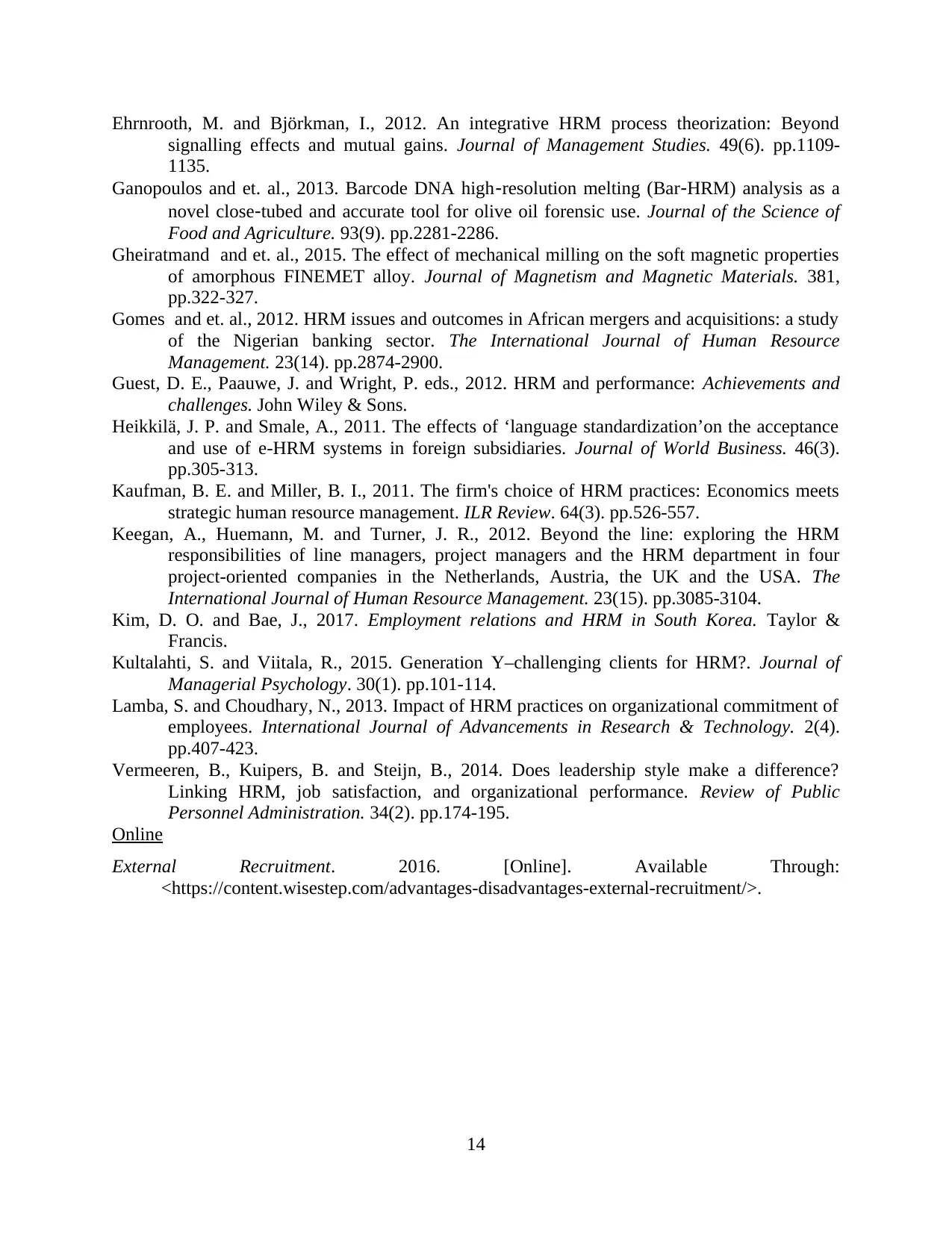
Ehrnrooth, M. and Björkman, I., 2012. An integrative HRM process theorization: Beyond
signalling effects and mutual gains. Journal of Management Studies. 49(6). pp.1109-
1135.
Ganopoulos and et. al., 2013. Barcode DNA high‐resolution melting (Bar‐HRM) analysis as a
novel close‐tubed and accurate tool for olive oil forensic use. Journal of the Science of
Food and Agriculture. 93(9). pp.2281-2286.
Gheiratmand and et. al., 2015. The effect of mechanical milling on the soft magnetic properties
of amorphous FINEMET alloy. Journal of Magnetism and Magnetic Materials. 381,
pp.322-327.
Gomes and et. al., 2012. HRM issues and outcomes in African mergers and acquisitions: a study
of the Nigerian banking sector. The International Journal of Human Resource
Management. 23(14). pp.2874-2900.
Guest, D. E., Paauwe, J. and Wright, P. eds., 2012. HRM and performance: Achievements and
challenges. John Wiley & Sons.
Heikkilä, J. P. and Smale, A., 2011. The effects of ‘language standardization’on the acceptance
and use of e-HRM systems in foreign subsidiaries. Journal of World Business. 46(3).
pp.305-313.
Kaufman, B. E. and Miller, B. I., 2011. The firm's choice of HRM practices: Economics meets
strategic human resource management. ILR Review. 64(3). pp.526-557.
Keegan, A., Huemann, M. and Turner, J. R., 2012. Beyond the line: exploring the HRM
responsibilities of line managers, project managers and the HRM department in four
project-oriented companies in the Netherlands, Austria, the UK and the USA. The
International Journal of Human Resource Management. 23(15). pp.3085-3104.
Kim, D. O. and Bae, J., 2017. Employment relations and HRM in South Korea. Taylor &
Francis.
Kultalahti, S. and Viitala, R., 2015. Generation Y–challenging clients for HRM?. Journal of
Managerial Psychology. 30(1). pp.101-114.
Lamba, S. and Choudhary, N., 2013. Impact of HRM practices on organizational commitment of
employees. International Journal of Advancements in Research & Technology. 2(4).
pp.407-423.
Vermeeren, B., Kuipers, B. and Steijn, B., 2014. Does leadership style make a difference?
Linking HRM, job satisfaction, and organizational performance. Review of Public
Personnel Administration. 34(2). pp.174-195.
Online
External Recruitment. 2016. [Online]. Available Through:
<https://content.wisestep.com/advantages-disadvantages-external-recruitment/>.
14
signalling effects and mutual gains. Journal of Management Studies. 49(6). pp.1109-
1135.
Ganopoulos and et. al., 2013. Barcode DNA high‐resolution melting (Bar‐HRM) analysis as a
novel close‐tubed and accurate tool for olive oil forensic use. Journal of the Science of
Food and Agriculture. 93(9). pp.2281-2286.
Gheiratmand and et. al., 2015. The effect of mechanical milling on the soft magnetic properties
of amorphous FINEMET alloy. Journal of Magnetism and Magnetic Materials. 381,
pp.322-327.
Gomes and et. al., 2012. HRM issues and outcomes in African mergers and acquisitions: a study
of the Nigerian banking sector. The International Journal of Human Resource
Management. 23(14). pp.2874-2900.
Guest, D. E., Paauwe, J. and Wright, P. eds., 2012. HRM and performance: Achievements and
challenges. John Wiley & Sons.
Heikkilä, J. P. and Smale, A., 2011. The effects of ‘language standardization’on the acceptance
and use of e-HRM systems in foreign subsidiaries. Journal of World Business. 46(3).
pp.305-313.
Kaufman, B. E. and Miller, B. I., 2011. The firm's choice of HRM practices: Economics meets
strategic human resource management. ILR Review. 64(3). pp.526-557.
Keegan, A., Huemann, M. and Turner, J. R., 2012. Beyond the line: exploring the HRM
responsibilities of line managers, project managers and the HRM department in four
project-oriented companies in the Netherlands, Austria, the UK and the USA. The
International Journal of Human Resource Management. 23(15). pp.3085-3104.
Kim, D. O. and Bae, J., 2017. Employment relations and HRM in South Korea. Taylor &
Francis.
Kultalahti, S. and Viitala, R., 2015. Generation Y–challenging clients for HRM?. Journal of
Managerial Psychology. 30(1). pp.101-114.
Lamba, S. and Choudhary, N., 2013. Impact of HRM practices on organizational commitment of
employees. International Journal of Advancements in Research & Technology. 2(4).
pp.407-423.
Vermeeren, B., Kuipers, B. and Steijn, B., 2014. Does leadership style make a difference?
Linking HRM, job satisfaction, and organizational performance. Review of Public
Personnel Administration. 34(2). pp.174-195.
Online
External Recruitment. 2016. [Online]. Available Through:
<https://content.wisestep.com/advantages-disadvantages-external-recruitment/>.
14
1 out of 16
Related Documents
Your All-in-One AI-Powered Toolkit for Academic Success.
+13062052269
info@desklib.com
Available 24*7 on WhatsApp / Email
![[object Object]](/_next/static/media/star-bottom.7253800d.svg)
Unlock your academic potential
© 2024 | Zucol Services PVT LTD | All rights reserved.





